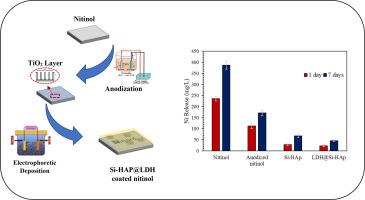在Si-HAp涂层中加入Zn/Sr-Ga基LDH颗粒控制镍钛诺合金的腐蚀
IF 2.8
Q1 MATERIALS SCIENCE, CERAMICS
引用次数: 0
摘要
金属植入物,特别是镍钛诺,有许多生物医学应用;然而,它们有固有的缺点,如耐腐蚀性和耐磨性差,并遭受镍离子浸出。为了解决这些挑战,本文探索了硅取代羟基磷灰石(Si-HAp)涂层的使用,该涂层采用电泳沉积(EPD)沉积Zn/Sr-Ga基层状双氢氧化物(LDH)颗粒。研究了合成的Zn/Sr-Ga基LDH颗粒作为Si-HAp涂层的被动填料和主动填料。对镍钛诺基板进行了阳极氧化预处理,以改善基板与涂层之间的附着力。优化了EPD参数,制备了均匀稳定的负载Zn/Sr-Ga LDH颗粒的Si-HAp涂层。采用不同的技术对Si-HAp复合涂层的形貌、组成和电化学性能进行了表征。电化学阻抗谱(EIS)和极化研究表明,与纯Si-HAp涂层和镍钛诺基体相比,添加Zn/Sr-Ga LDH颗粒的Si-HAp涂层的耐腐蚀性能有显著提高。LDH@Si-HAp-coated样品的镍释放量最低,表明LDH具有降低镍钛诺植入物毒性和增强其强度的潜力。本文章由计算机程序翻译,如有差异,请以英文原文为准。

Incorporation of Zn/Sr-Ga based LDH particles into Si-HAp coatings to control the corrosion of Nitinol alloys
Metallic implants, especially Nitinol, have numerous biomedical applications; however, they have inherent drawbacks, such as poor corrosion and wear resistance and suffer from nickel ion leaching. To address these challenges, this paper explores the use of silicon-substituted hydroxyapatite (Si-HAp) coatings with incorporated Zn/Sr-Ga based Layered Double Hydroxide (LDH) particles deposited by electrophoretic deposition (EPD). The synthesized Zn/Sr-Ga based LDH particles were investigated as both passive and active fillers in Si-HAp coatings. An anodization pre-treatment of the Nitinol substrates was performed to improve adhesion between the substrate and the coating. The EPD parameters were also optimized to prepare homogeneous and stable Si-HAp coatings loaded with Zn/Sr-Ga LDH particles. The morphology, composition, and electrochemical properties of the Si-HAp composite coatings were characterized using different techniques. Electrochemical impedance spectroscopy (EIS) and polarization studies demonstrated a significant improvement of the corrosion resistance properties of Si-HAp coatings with Zn/Sr-Ga LDH particles, compared to pure Si-HAp coatings and Nitinol substrate. The LDH@Si-HAp-coated sample showed the lowest nickel release, indicating the potential of LDH to reduce toxicity and enhance the strength of Nitinol implants.
求助全文
通过发布文献求助,成功后即可免费获取论文全文。
去求助
来源期刊

Open Ceramics
Materials Science-Materials Chemistry
CiteScore
4.20
自引率
0.00%
发文量
102
审稿时长
67 days
 求助内容:
求助内容: 应助结果提醒方式:
应助结果提醒方式:


